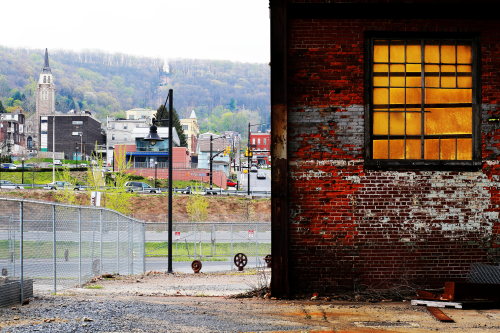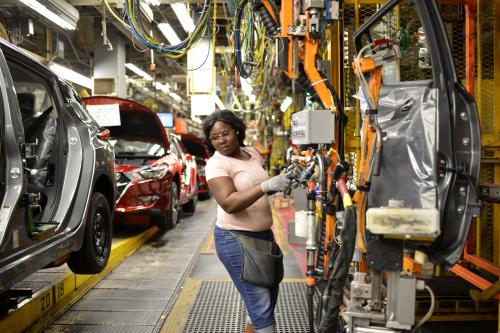One of the most disconcerting features of today’s polarized labor market is its stark “U-shape,” by which high-pay and low-pay occupational groups (like business-finance and food service, respectively) expand as a share of the national workforce, while middle-pay/middle-skill occupations (like sales and production) shrink.
We wrote about this “hollowing out” of the economy a while ago, and you can see here how it looks for the current decade:

In today’s divergent economy, “U-shapes” are everywhere!
And yet, what is that very tall bar on the low-skill left side of the “U” chart? Looming over all other occupational groups in our depiction, that especially tall bar reflects the super-fast growth of “personal care and service” occupations—often face-to-face service work. And there’s a story in that.
Personal care and services occupations, as defined by the U.S. Bureau of Labor Statistics, represent the fastest growing segment of the job market for non-college-educated workers and epitomize the eye-popping workings of a “bar-bell” economy in which the consumer demands of the well-off furnish a key source of growth in the low-skill economy.
Officially, this “care and service” job group includes, as depicted in the bar chart, such basic occupations as childcare workers and hairdressers.
But define the sector a little differently, as we did in a new but non-exhaustive analysis with Chris Rugaber of the Associated Press, and one arrives at a sizable, suggestive swath of 12 primarily care and service occupations catering especially to the personal needs of the burgeoning rich:

Call this “wealth work,” as Rugaber and MIT economist David Autor do, or “the servant economy,” as did Alexis Madrigal recently. Regardless of the label, many American cities are brimming with an explosion of low-end employment that has brought some three million workers into mostly low-paid, often-precarious service arrangements helping the well-off walk the dog, clean the house, cook dinner, manage money, and stay fit.
These workers are the nation’s 280,000 fitness trainers and aerobics instructors. They include our cities’ 103,000 massage therapists, their one million housekeepers, and yes, their personal financial advisers and manicurists, not to mention thousands of handymen and errand-runners whose work on TaskRabbit and various apps that facilitate work we are not able to isolate.
Not just a sign of our unequal times, wealth work is important both because it is now a significant feature of urban economies and because it presages at least one vision of the “future of work” at a time when society is wondering what such “new work” will look like.
Not just a sign of our unequal times, wealth work is important both because it is now a significant feature of urban economies and because it presages at least one vision of the “future of work” at a time when society is wondering what such “new work” will look like.
As a swath of the urban economy, the table above suggest that wealth work is growing rapidly (sometimes spectacularly), doesn’t pay very well, and is mostly a full-time job for workers lacking a college degree. What’s more, wealth workers are far more likely than the average worker to be women and Hispanic.
Beyond that, wealth work is unevenly distributed across the nation’s cities, and clusters in the metros in which rich people live or travel to. The mapping below shows that the largest concentrations of wealth workers toil in a combination of the nation’s biggest coastal “superstar” cities such as Bridgeport, Conn. and New York and San Francisco (where the “winners” of the nation’s polarized economy reside) as well as in its resort centers like Hilton Head, S.C., Bend, Ore., and Kahului, Hawaii (to which the nation’s “haves” travel) for relaxation.

Look beneath the visual impression, and the association of wealth and wealth work is clear:

Wealth work tends to be concentrated in metros where high-income households have, on average, higher incomes as well as in an array of leisure towns like Ocean City, N.J. and Napa, Calif. Add it up and wealth work comprises 3 percent of the employment in the richest 20 metropolitan areas but only 2 percent of it in the rest of the nation’s urban regions. In this respect, the location of wealth work reflects the geography of wealth, which in turn reflects the amenity choices of high-income consumers who are overrepresented in big cities.
As to what it means for the nation that wealth work is supporting many of the fastest-growing occupations accessible to workers without a college degree, the implications are ambiguous, but concerning.
“What’s new here?” is one possible reaction. The inequalities of capitalist economies are “not exactly news,” as Madrigal acknowledges. And so, it’s true that the “wealth” economy in some ways simply expresses in the labor market the gargantuan power divides between America’s growing aristocracy and everyone else, including especially the millions without a college degree. In that sense, the explosion of wealth work reflects the pervasive fact that some people can buy other people’s time at little personal cost.
At the same time, though, the spread of wealth work portends more unsettling dynamics involving the interplay of technology and work.
On the upside, the growth of wealth work underscores that the current age of automation has not been jobless. The coexistence of automation and work was a key point of our recent analysis of automation trends in the labor market, and the rise of wealth work is a perfect example of the way Autor and scholars Daron Acemoglu and Pascual Restrepo say automation “reinstates” some work by generating new labor-demanding work even as it displaces work from existing tasks. This is the reassuring part of the equation: Even as automation has been “hollowing out” the job distribution by substituting for “middle-skill” production, clerical, and administrative support tasks, it has boosted the productivity and incomes of high-skill workers and allowed them to spend more on consumption, creating significant new demand for personal services. To the extent that many of the resulting jobs tend to be nonroutine, manual, and often interpersonal positions, they may well be durable ones even in the face of technology. So that’s good.
The problem, on the downside, is the poor, even dystopian, quality of wealth work and what that may presage. The growth of wealth work, after all, looks mostly to mean more job growth at the lower end of the pay spectrum, among jobs paying no more than $30,000 or $40,000 a year. In theory, other jobs that automation and AI generate in the future will be higher-paying and more secure. As it stands now, though, wealth work remains one of the largest and fastest-growing categories of “new work,” which does not appear a very secure or promising domain of labor in Rugaber’s story. With pay at just $25,000 a year, non-farm animal caretaking (think dogwalking) may be a good way to earn a little money, but if the fastest-growing segment of the non-college job market continues to revolve around menial tasks involving the care and feeding of the rich it’s hard to see how large numbers of workers will maintain decent livelihoods, accumulate skills to move into higher-paying employment, and retain their dignity and commitment to democracy.
Add in the drive of Silicon Valley VC to “gig-ify” the wealth economy with dozens of “Uber-for-X” task and delivery services, and the wealth-work phenomenon looks even more disquieting. In the space of just a few years, a slew of VC-funded concerns like TaskRabbit, Washio, and DoorDash have been scaling up massive platforms for reorganizing low-paying work, linking the well-off to the struggling, and conveying the bulk of the work into “contingent,” no- or low-benefits non-contractual arrangements. In that light, wealth work takes on what Madrigal calls a “strange pall” because it converts the dealings of the “haves and the have-nots” into the online exchanges of the “demanding and the on-demand.” That’s a queasy, highly ambiguous perspective.
The hope would be that wealth work reflects a mutually beneficial exchange through which time-stretched, richer Americans buy up services from the people who most need jobs—”those with no work and lots of time on their hands,” as Danielle Kurtzleben has written. The fear is that these exchanges are, instead, a picture of an unhealthy, unbalanced society.
(Click here for downloadable Excel data on the share of jobs in wealth work and the average household income for all metropolitan areas.)








Commentary
Who’s employed by the lifestyles of the rich and famous?
July 30, 2019